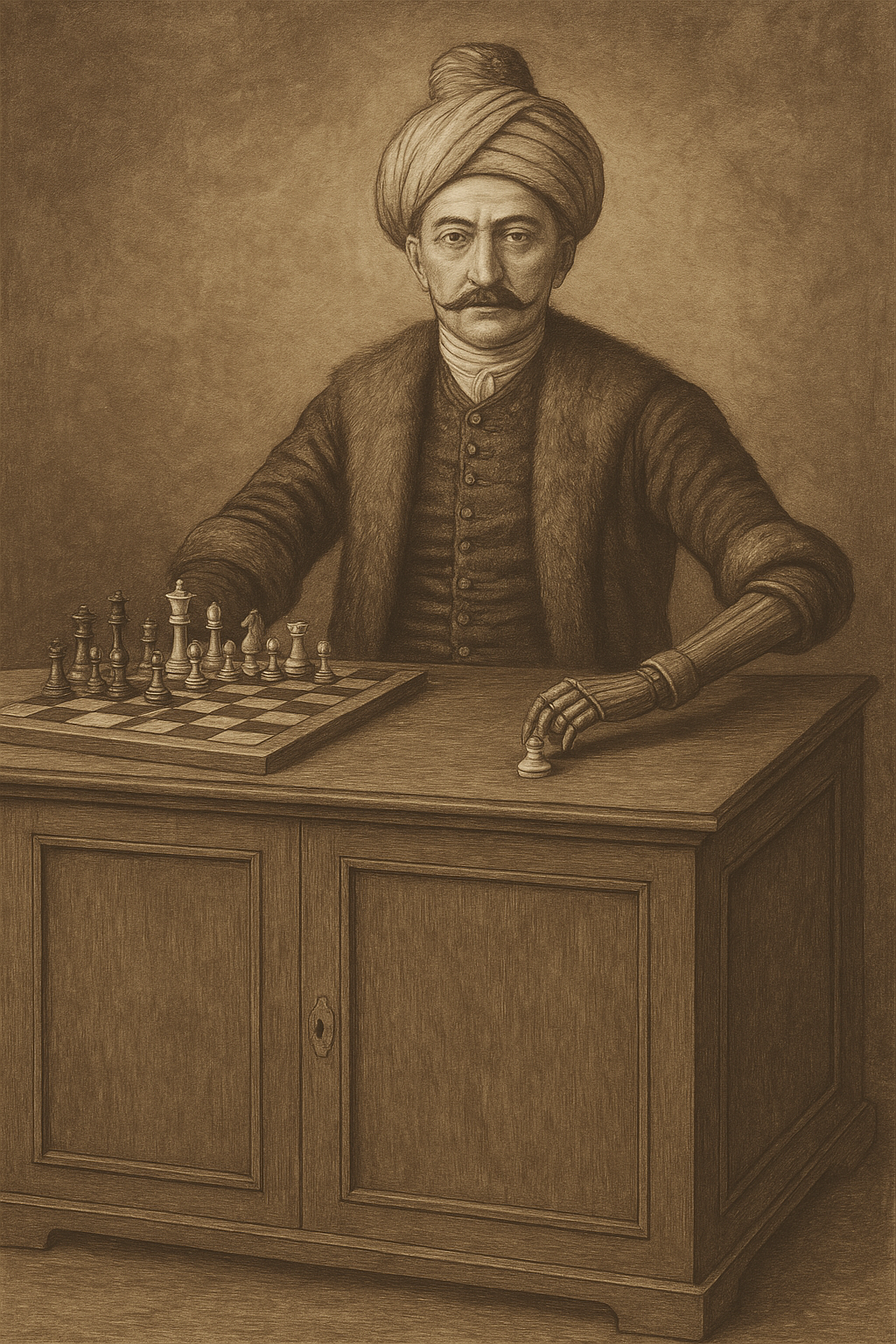The Mechanical Turk (1770): The Robot That Fooled the World
10/21/2025

The Mechanical Turk (1770): The Robot That Fooled the World
The Birth of a Miracle
Vienna, 1770. The city shimmered under the glow of candlelight and powdered ambition. Within the grand halls of Empress Maria Theresa’s court, nobles gathered — their curiosity as thick as the perfume in the air.
Into this world of waltzes and whispers stepped Wolfgang von Kempelen, a Hungarian civil servant, engineer, and part-time magician of machines.
A man who once declared, “I will build a machine that can think like a man.”
To impress the Empress, Kempelen unveiled a strange contraption: a life-sized wooden figure dressed as an Ottoman nobleman, seated behind a cabinet adorned with brass gears, stars, and a chessboard on top.
The figure’s dark eyes stared blankly, its left hand resting calmly while the right hovered above the chessboard — ready, almost human.
When the inventor turned a crank, a low hum filled the chamber.
The figure came to life. Its arm moved with eerie precision, grasping a piece and sliding it across the board.
Check.
A hush fell over the court. The Empress leaned forward, eyes wide with astonishment. The nobles exchanged glances.
Had this man really created an automaton that could play — and win — at chess?
In that moment, the impossible seemed real.
The Rise of a Legend
Word spread across Europe like wildfire.
Kempelen’s creation — now known as “The Mechanical Turk” — became the marvel of the century.
From Paris to London, St. Petersburg to Prague, people queued for hours to witness the miracle machine.
The Turk would nod when it checkmated its opponent, shake its head if a move was foolish, and even drum its fingers impatiently while waiting for the player to respond.
It wasn’t just mechanical movement — it was personality.
Among its challengers were some of history’s greatest minds:
-
Benjamin Franklin, who walked away muttering, “It plays with a purpose.”
-
Napoleon Bonaparte, who mischievously tried to cheat — only for the Turk to swipe the piece off the board in protest, leaving the audience in laughter.
Europe was spellbound.
The Enlightenment era — obsessed with logic, machines, and human reason — finally had its symbol: a wooden man that thought.
The Whisper of Doubt
Yet, beneath the applause, there was unease.
Could a clockwork mechanism truly outsmart human intellect?
Philosophers debated it fiercely. Some claimed the Turk was guided by magnets and gears; others believed Kempelen had invented a form of mechanical reasoning.
There were even rumours of occult involvement — that perhaps a trapped spirit guided the hand of the automaton.
The mystery only deepened when Kempelen refused to explain.
He simply smiled and said,
“Gentlemen, it is not enough to create a machine — one must also create wonder.”
For over 20 years, the Turk dazzled Europe.
After Kempelen’s death, the machine was sold to a showman named Johann Nepomuk Maelzel, who toured it across continents. He took it to America, where it became an attraction in cities like New York, Boston, and Philadelphia.
There, it inspired young dreamers — among them Edgar Allan Poe, who attended a show and later wrote an essay titled “Maelzel’s Chess Player.”
Poe dissected the illusion, insisting that somewhere within the cabinet, there must be a hidden man.
“It is the ingenuity of concealment that we applaud,” he wrote, “not the power of the machine.”
The Hidden Man
Years later, when the Turk was finally dismantled for repair, the truth emerged.
Inside the ornate cabinet — behind the fake gears and sliding panels — was a narrow compartment barely large enough for a man to crouch.
Hidden within it sat a human chess master, using a complex system of levers, magnets, and mirrors to control the automaton’s arm.
He could see the chessboard through a sliding panel lit by a candle, while his own movements guided the Turk’s every motion.
The deception was stunningly sophisticated.
The Turk was not a robot — it was a theatre of engineering.
But perhaps what made it so enduring wasn’t the trick itself — it was the belief it inspired.
People wanted to believe in the future. They wanted to believe that a machine could think.
Fire and Legacy
In 1854, The Mechanical Turk met a tragic end when a fire destroyed the museum in Philadelphia where it was housed.
The ashes revealed little more than twisted metal and fragments of wood.
The illusion that once captured the imagination of Europe was gone.
But its spirit lived on — in every machine that dared to think.
Kempelen’s “fake robot” would go on to inspire a generation of scientists who actually made artificial intelligence real.
Charles Babbage, the father of computing, admired the idea of mechanical logic.
Alan Turing, more than a century later, would ask a question that echoed The Turk’s deception:
“Can machines think — or do they only appear to think?”
In 2005, when Amazon launched its crowdsourced AI platform, it named it “Amazon Mechanical Turk” — a nod to the 18th-century marvel that blurred the boundary between man and machine.
Reflections from the Ashes
The Mechanical Turk was, at its heart, a lie — but a beautiful one.
It reminded the world that illusion can lead to innovation, and that even deception can ignite discovery.
What Kempelen built wasn’t artificial intelligence — it was artificial imagination.
It made people wonder what if.
And sometimes, that question is what drives humanity forward.
Final Thought:
“The Turk may have been hollow, but it gave birth to the idea that still fills our machines with dreams.”